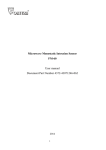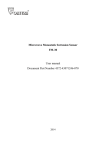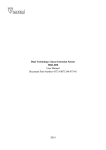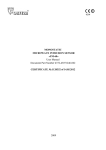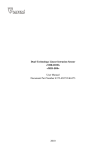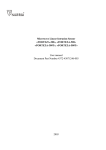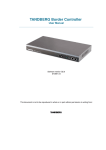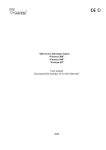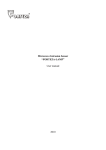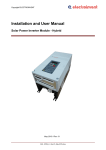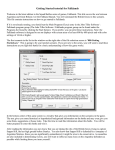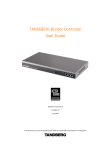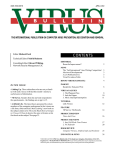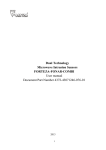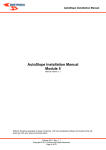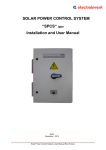Download Local Radiowave Protective Volumetric Detector
Transcript
Microwave Monostatic Intrusion Sensor FM-60 (24) User manual Document Part Number 4372-43071246-087-01 2014 1 CONTENTS 1. 2. 3. 4. 5. 5.1. 6. 7. 8. 8.1. 8.2. 8.3. 8.4. 9. 10. 11. 12. 13. 14. 15. 16. Introduction ......................................................................................................... 3 Purpose ................................................................................................................ 3 Specifications ...................................................................................................... 3 Sensor components.............................................................................................. 5 Sensor structure & operation............................................................................... 6 Sensor principle of operation .............................................................................. 6 Sensor construction ............................................................................................. 6 Safety measures... ................................................................................................ 9 Mounting procedure ............................................................................................ 9 Requirements for the protected sector ................................................................ 9 Requirements for the protected room.................................................................. 10 Sensor mounting on the perimeter sector ............................................................ 10 Sensor mounting on the wall ............................................................................... 12 Sensor preparation for the operation & adjustment ............................................ 12 Adjustment with a PC ......................................................................................... 14 Maintenance ........................................................................................................ 27 Troubleshooting guide ........................................................................................ 28 Storage ................................................................................................................. 29 Transportation ..................................................................................................... 29 Acceptance certificate ......................................................................................... 29 Warranty .............................................................................................................. 29 2 1. INTRODUCTION 1.1. The user manual contains the following information about the microwave monostatic intrusion sensor FM-60 (24) (below the sensor): purpose and sensor principle of operation; sensor components and possible delivery sets; sensor specifications and its components; operating and servicing rules. There is the information about tare, packaging and conditions of the sensor transportation. This document contains the required information for the correct operation, maintenance and storage of the sensor. The manufacturer constantly improves the sensor and reserves the right to make changes to its construction, which does not worsen the sensor specifications. 2. PURPOSE 2.1. 2.2 2.3. The purpose of FM-60 (24) is to protect perimeter sites, open and closed grounds of different objects and to detect an intruder moving at his “full height” or “bent” in the detection zone. The sensor application on the perimeter sites having powerful sources of electromagnetic emission (radars, radio transmitting stations, etc.) is determined by the trial operation. The sensor is intended for continuous round-the-clock outdoor operation at an ambient temperature from -40oC up to +80С and relative humidity up to 98% at the temperature +35С. The sensor distinctive feature is the detection zone consisting of 12 cross-cut subzones. They can be regulated directly with the controllers on the sensor or with a PC through USB interface (subzones disconnection, sensitivity adjustment of every subzone, ANTIMASKING function and etc.) or through RS485 interface. 3. SPECIFICATIONS 3.1. The maximum detection zone length is 60 m (12 cross-cut subzones of 5 m). The detection zone is a volumetric part of the protected sector, any intruder movement in which disturbs the field and generates an alarm. The sensor can be performed in one of 5 frequency letters L1, L2, L3, L4 and L5 to eliminate the overlapping during the mutual sensors operation. If it is necessary to divide the sensors into the frequency letters, please indicate it at your order. 3 The detection zone characteristics are given in Table 3.1. Table 3.1 Characteristic FM-60 (24) Width, m not less than 3 Height, m not less than 8 3.2. 3.3. The detection zone length can be regulated from 5 m up to 60 m. The sensor generates an alarm when: an intruder (moving at his “full height” or ”bent”) crosses the detection zone at a speed from 0,3 up to 8 m/sec with the minimum detection probability 0,98; the absence of supply voltage. The alarm is generated by breaking the actuating optoelectronic relay contacts for 3 sec minimum. This signal is transmitted by the yellow and pink wires. 3.3.1. The ANTIMASKING signal is generated after 20 sec. of sabotage attempts with the radiation screening using radio reflecting or radio absorptive materials at the distance up to 0,5 m. The ANTIMASKING signal is generated by breaking the actuating optoelectronic relay contacts for an indefinite time. The sensor turns to the operating mode when masking objects are removed and the check pass in the nearest detection zone is done. 3.4. The characteristics of the actuating optoelectronic relay are: the maximum switching current is 0,1 A; the maximum voltage is 50 V; the maximum resistance is 130 Ohm in the closed condition (with the lightning guard elements). 3.5. The sensor generates an alarm at the opening of the cover, under which there is USB connector. The contacts of the blocking button are open at the cover opening. This alarm is performed by blue and grey cables. Operating characteristics of the blocking contacts: the current is up to 0,2 A at the voltage up to 80 V. 3.6. The recovery time of the standby mode after an alarm is up to 1 sec. 3.7. The time of the technical availability after the supply voltage signal is up to 5 sec. 3.8. The sensor power supply: from 12 up to 30 VDC with the maximum pulsation of 0,03 V. The maximum power consumption is 1 W. 3.9. The sensor has the automatic and remote control. 3.10. The sensor doesn’t generate an alarm at: rain, snow, fog; solar radiation; wind speed up to 20 m/sec; 4 - 3.11. 3.12. 3.13. 3.14. 3.15. birds and small animals in the detection zone with the linear dimensions up to 0,3 m; irregularities up to + 0,3 m on the protected site; snow cover up to 0,3m (without additional adjustment); grass up to 0,2 m; influence of ultra short waves emissions of the range 433 MHz and mobile phones at the distance more than 0,5 m from the sensor. The sensor is immune to electromagnetic interferences (voltage impulses in supply circuits, breaks of mains supply, electrostatic discharges and electromagnetic fields). Input circuits of the sensor are protected from electric pickup (including electric storms). The sensor mean lifetime is 8 years. Maximum dimensions of the units without a mounting kit, mm: 210х135х55; Maximum weight, kg: 0,5. 4. SENSOR COMPONENTS 4.1. 4.2. The sensor delivery set: - transceiver – 1 pc; - mounting kit on a support (MK-1): - bracket – 1 pc; - buckle – 2 pcs; - key S8x10 – 1 pc; - user manual – 1 pc; - package. The following components can be supplied by special order: - USB cable A-B for connection with a PC; - protocol converter RS485 (RS485-COM, RS485-USB); - software *; - mounting kit on a wall (MK-2); - power supply unit PSU-U-15-0,15; - junction box JB-15 or JB-30; - bracket to fix BRACKET-120, BRACKET-350, BRACKET-500. * The software is required and downloaded free of charge following the offered links. 5 5. SENSOR STRUCTURE & OPERATION 5.1. Sensor principle of operation 5.1.1. The sensor principle of operation is based on the method of linear frequency modulation, which is widely used in radiolocation where the generator operating frequency is changed linearly within small range. The super-high-frequency transmitter of the transceiver radiates electromagnetic oscillations in the direction of the protected zone. The electromagnetic oscillations are reflected from the goal and surrounding objects and get to the super-high-frequency receiver of the transceiver unit. When an intruder moves in the detection zone, the changes in the received signal caused by the Doppler Effect are intensified and processed according to the algorithm. If these changes exceed the threshold value, the sensor generates an alarm. The method of linear frequency modulation and 12 cross-cut subzones increase the sensor interference immunity and reduce the false alarm rate. 6. SENSOR CONSTRUCTION 6.1. 6.2. 6.3. 6.4. The sensor construction and its installation on the support are given in fig.6.1. The sensor construction is the following: the monoblock placed in the dust- and splash-proof enclosure. The bearing structure is the base 4. On the base 4 there are the microstrip antenna and the signal processing board, protected with the radio transparent cover 5. There are two bores in the lower part of the cover 5 for condensation prevention inside the unit. It is necessary to take off the cover 6 to get the access to the adjustment and indication elements. The sensor is connected to the receiving-control device with the cable 8 stretched through the cable gland 7 and the corrugated pipe 12. The transceiver is mounted on the support 1 with the bracket and the buckles 13 as shown in fig. 6.1. The mounting kit ST-1 provides the unit turn on horizontal plane for 360 º, on vertical plane: up - 15º minimum, down - 40º minimum. The transceiver is mounted on a vertical plane (wall, fence, etc.) with the bracket: bracket 2 as shown in fig.6.2. The rotation angles on the bracket on a horizontal plane are 180º, on a vertical plane: up - 17º, down - 45º. There are 3 types of the bracket: indented from a wall at the distance of 120 mm, 350 mm and 500 mm. The type of the bracket depends on the sensor application. The transceiver is mounted along to the wall and to other long surfaces with the brackets installed at 350 mm from the wall. It is necessary to do it because of absorption and reflection from the wall the sensor technical characteristics can worsen. 6 1-support (pipe) 2-bracket 3- bushing 4-base 5-case 6-cover 7-cable gland – 1 pc; – 1 pc; – 1 pc; – 1 pc; – 1 pc; – 1 pc; – 1 pc; 8-cable – 1 pc; 9- bolt M6x35 – 2 pcs; 10-nut M6 – 1 pc; 11-washer 6 – 2 pcs; 12- corrugated pipe 13-buckle – 2 pcs; Fig. 6.1 Mounting on a support 7 1- support (wall) 2- bracket 3- figured washer 4- base 5- case 6- cover 13- screw 4x30 14- screw plug 15- corrugated pipe – 1 pc; – 2 pcs; – 1 pc; – 1 pc; – 1 pc; – 3 pcs; – 3 pcs; 7- cable gland 8- cable 9- ring 10- nut M6 11- washer 6 12- bolt M6x16 Fig. 6.2 Mounting on a wall with a bracket of 120 mm 8 – 1 pc; – 1 pc; – 1 pc; – 1 pc; – 2 pcs; – 1 pc; Note. Dear user! Manufacturer of the sensor FM-60 (24) constantly upgrades its quality and reliability. That’s why in some lots of sensors there can be design modifications unspecified in the documents delivered with the sensors. Nevertheless, the main specifications are valid. 7. SAFETY MEASURES 7.1. 7.2. 7.3. 7.4. 7.5. 7.6. The current safety standards for the operation with electrical facilities with the voltage up to 1000 V should be observed during mounting, preventive maintenance and repair of the sensor. Cables should be laid, terminated and connected to the sockets only when the supply voltage is OFF. The power of the super high frequency energy, beaming by the sensor satisfies the security standards and doesn’t have any deleterious effect on human health. It is prohibited to mount and maintain the sensor at thunderstorms. Installation and maintenance of the sensor should be performed only by people, who underwent special safety trainings. The breach of requirements of this user manual can provoke the sensor breakdown. 8. MOUNTING PROCEDURE 8.1. Requirements to the protected sector 8.1.1. The choice of the place and the correct sensor mounting on the protected sector or in the protected room are the basic factors, which provide its operational reliability. The protected sector should meet the following requirements: a) height of irregularities – up to +0,3 m. If irregularities exceed +0,3 m, the sensor characteristics can worsen. Under these conditions the possibility of the sensor usage is defined by the trial operation; b) on the sector there should not be high grass, bushes and tree branches at the distance of 5 m minimum from the detection zone border; c) big objects moving in the wind (folds gates, tumbledown fences, etc.) should not be located in the sensor detection zone) and behind the detection zone border at the distance of 20 m minimum; d) grass height up to 0,2 m; e) snow height up to 0,3 m; 9 f) g) h) i) movement of people and animals are not permitted at the distance 5…10 m minimum from the detection zone borders; it is recommended to enclose the detection zone with a fence (from 1 m height) to eliminate casual movements of people and animals; gutter from the roof should not be near the sensor enclosure at sensor installation on an outside wall; it is necessary to install a safety visor. 8.2. Requirements to the protected room 8.2.1. The protected room should meet the following requirements: a) sensors should not be mounted on walls subjected to constant vibrations; b) animals, birds, vibrating or moving objects (vent lights, doors, airexhausters, etc.) should not be in the protected room; c) if the sensor is installed in a room with a big square of glazing (shops, expo halls, offices, etc.) the area of 3 m minimum should be free of trees and moving transport; d) the sensor should not be directed to windows and thin partitions between rooms; e) it is not necessary to install a safety visor. 8.3. Sensor mounting on the perimeter sector 8.3.1. For supports it is recommended to use metal or asbestos-cement tube of 70…90 mm diameter. For hard soils (argil, stone, etc.), the support should not be concreted and embedded in the soil of 600…800 mm. For light soils (sand, etc.) the concrete mat for the support should be 200 mm depth and 500 mm diameter. In snowy regions (more than 1 m height), the support superstructure should not be less than 1500 mm. In not snowy regions the support superstructure should be up to 1300 mm. If the sensor is used to block the upper part of the fence, it is recommended to weld or to gear together the support and the fence for firmness. In this case the support should be situated above the fence at 300 mm minimum. 8.3.2. Lay the main cables according to the project of the security system. It is recommended to use multiple cables with the core screen or metal sheath. The cables laying may be performed in the ground or along the fence. 8.3.3. The mounting height is 0,8…1,0 m as shown in fig.6.1. To install the sensor on the round support, the mounting kit MK-1 is used. Install the bracket 2 on the support 1 with the buckles 13. 10 8.3.4. Install the transceiver on the bracket with the bolt 9 (with drainage bores downward). The bracket should be pointed on the support so that the cover surface of the sensor is directed to the protected sector. 8.3.5. Fix the sensor at a horizontal position (relative to the ground) with the bolt 9. The model of the detection zone form and its dimensions are shown in fig. 8.1. Fig. 8.1 Detection zone parameters of the sensor FM-60 (24) Notes. The given dimensions and the detection zone configurations are intended for the ideal conditions of the perimeter area without taking into account the ambient conditions. Practically, the dimensions and the detection zone configurations can differ from the given ones because of ambient objects, reflecting surfaces and the detection sensitivity. 8.3.6. Take into account that the signal level reflecting from a moving intruder depends on his visibility (the reflection square). So, for example, the sensor watching from above the intruder’s movement will be generate an alarm less than the same sensor watching in front or side-on. That’s why during the sensor installation when the angle between the detection zone axis and the ground surface is ≥ 45˚, the signal level can be reduced when the intruder moves in the detection zone. To detect this intruder more exactly, it is necessary to reduce the operation threshold; it provides the interference decrease. 11 8.4. Sensor mounting on the wall 8.4.1. Make the marking in the chosen place as shown in fig.6.2. Fix the bracket 2 with the screws 6 on the wall 1. The brackets BRACKET-120 (the distance from the wall to the bracket is 120 mm), BRACKET-350 (the distance from the wall to the bracket is 350 mm), BRACKET-500 (the distance from the wall to the bracket is 500 mm) are used for the wall mounting and are ordered separately. Insert the bolt 12 in the slot of the ring 9 and fasten the transceiver on the bracket 2. Loosen the nut 10 and point the unit on the necessary direction turning it in a horizontal surface. Tighten the nut 10. Moving the transceiver in a vertical surface relative to the ring slot 9, align the unit in a vertical surface and tighten it with the bolt 12. 8.4.2. The sensor can be performed in one of 5 frequency letters L1, L2, L3, L4 and L5 to eliminate the overlapping during the mutual sensors operation. CAUTION! 1. IT IS FORBIDDEN TO INSTALL THE SENSORS WITH THE IDENTICAL FREQUENCY LETTERS ON THE PROTECTED AREA. Ordering the sensors with the different frequency letters, it is necessary to follow the project documentation of the object. If you use more than 5 sensors on your perimeter site, the possibility of their use is determined by trial operation. 2. If you install the sensor by other methods different from the User manual ones, the possibility of their use is determined by trial operation. 9. SENSOR PREPARATION FOR THE OPERATION & ADJUSTMENT 9.1. Install the sensor according to the item 8 and connect supply and output circuits of the sensor according to the color marking of cables as shown in Table 9.1. Table 9.1 Color marking of cables white brown yellow pink green grey blue red Purpose Supply plus Supply minus Relay contacts (normally closed) Relay contacts (normally closed) Tamper circuit (TAMPER) Tamper circuit (TAMPER) RS485 B RS485 A 12 The sensor connection diagram using the lightning guard unit LGU-4 and the power supply unit PSU-U-15-0,15 is shown in fig. 9.1. The tamper contacts are connected in series with the actuating relay contacts. In this case an alarm will be registered by one channel of the receiving-control device at the relay actuation or at the opening of the sensor cover. Fig. 9.1 Sensor connection diagram using the lightning guard unit LGU-4 The micro switch positions and the detection zone length are given in Table 9.2. Table 9.2 Subzone number 1 2 3 4 5 Subzone range from the sensor 0-5 m 5-10 m 10-15 m 15-20 m 20-25 m 13 6 7 8 9 10 11 12 9.2. 25-30 m 30-35 m 35-40 m 40-45 m 45-50 m 50-55 m 55-60 m The DETECTION ZONE LIMITATION or the “APPROVED PASSAGES”, i.e. the subzone disconnection is performed with a PC. If the corresponding subzone is switched OFF, the sensor does not generate an alarm if the detection zone is crossed in this place. CAUTION! Avoid the adjustment of very high sensitivity to eliminate false alarms! To reduce the quantity of false alarms, switch ON the subzones which are necessary for its application. 10. SENSOR ADJUSTMENT WITH A PC 10.1. 10.2. The sensor can be adjusted with a PC. It provides an opportunity to form a complex detection zone, set complex sensitivity and different modes of the sensor operation. The sensor connection with a PC is performed with a standard connective cable USB A-USB B. To control the sensor with a computer, it is necessary to set up the software, which includes 2 stages: virtual COM-port setup and sensor control program one. COM-port setup Put the disc (of the delivery kit) in the computer. Connect the sensor to the computer with USB cable. The supply is not obligatory for the sensor. The computer will identify the type of USB device and will ask to install the driver. For that follow the fig. 10.1-10.4. 14 Fig.10.1 Fig.10.2 Please choose the folder SOURCE/COM-PORT from CD-disc in the window Search and installation options. 15 Fig.10.3 Fig.10.4 16 After clicking Finish the computer will install one more Virtual COM-PORT driver. This operation is similar to the previous one. When COM-PORT setup is finished, it is necessary to know its number. Please follow: START → SETUP → CONTROL PANEL → SYSTEM → DEVICE → DEVICES MANAGER → PORT (COM and LPT) →USB SERIAL PORT and remember the number. 10.3. Sensor Control Program setup Setup the programs from the folder SOURCE on the computer from the setup disc. Setup the program ConfigMaster_setup.exe. After that you will see the following window: Fig.10.5 17 Setup the software: Fig.10.6 Fig.10.7 18 Fig.10.8 The software setup is finished. 10.4. The sensor operation with a PC Connect the sensor to the computer with USB cable, supply the sensor. Launch the program ConfigMaster from the desktop window. The following window should be launched after it (fig.10.9). Fig.10.9 19 Click Settings and choose COM-PORT according to the Virtual COM-PORT number. The window Settings is given in fig.10.10. Fig.10.10 After that click Save. The sensor communication with a PC is performed after clicking Begin communication. The indicator Connection status switches over from grey to green color. The desktop window will have the following view as shown in fig.10.11. A red color of the indicator Connection status says about the sensor connection absence with a PC. In this case check USB cable connection and COM-PORT correct setup. After that the desktop window will have the following view as shown in fig.10.11. 20 Fig.10.11 The program displays only the controllers’ state, the signals and noise levels in every subzone. The sensor is controlled only by the built-in controllers. This program permits to check the sensor adjustment during the operation. To perform the control from a PC, it is necessary to click Control from PC in the desktop window. The desktop window will have the following view as shown in fig.10.12. The control from a PC provides all the sensor abilities: a complex detection zone generation (“approved passages”, necessary sensitivity setup in each subzone, the interference control) and the function ANTIMASKING. CAUTION! The function ANTIMASKING permits to reduce the sensor detection ability and to increase the quantity of false alarms. 21 Fig.10.12 The desktop window displays the signal and noise levels in the subzones, 12 independent thresholds controllers in the subzones, the mode switch Operation/Adjustment, the buttons Save in memory and Return to factory settings. You can switch ON/OFF some separate subzones with the checks situated under the indicators of the signal level. Also you can switch ON/OFF the function ANTIMASKING. The button Save in memory saves all the changes; the button Return to factory settings displays the thresholds values and the signal gain in the value of “50%”. During the mode switching over (from Operation to Adjustment mode) you can setup the signal gain for each subzone, e.g. as given it in fig.10.13. 22 Fig.10.13 You see all the information about the connection (port number, baud rate, parity, stop bit, logical number, and port state), the sensor information and its state. Operating over RS-485 interface you can specify the logical number (address) of the sensor. For that right-click in the main window and choose Change a logical number. After that you will see the window given in fig.10.14. When you type a new logical number and click OK, this number will be assigned to the sensor; the program is automatically launched with this new logical number. 23 Fig.10.14 As an example, let’s consider the sensor adjustment to generate the complex detection zone. It is necessary to generate the detection zone of the length 20 m and with the “approved passage” in 4 and 5 subzone. The sensor is adjusted by 2 persons. To generate the detection zone, change the mode Control from PC. Choose the necessary detection zone length with the checks, i.e. switch OFF 9-12 subzones. Turn she switch Operation/Adjustment in the Adjustment mode. The desktop will have a view as given in fig.10.13.The signal gain setup is performed in every subzone. The signal level in every subzone is displayed with a green column. If the threshold level is exceeded, the column becomes red. The factory setup of the threshold level is 50% from the full scale. If there are not any moving objects in the detection zone, an alarm generation in the subzones will say about a noise level (some 24 noises). These noises can be provoked by the requirements non-fulfillment to the protected area (high grass and other moving objects), powerful sources of electromagnetic emissions, mutual sensors influence with the same frequency letter. The interference level exceeded 20 % from the full scale can provoke some false alarms. In this case you have to eliminate the causes provoked a non-accepted noise level. The sensor is adjusted by 2 persons: the first does some “approved passages” in each subzone; the second one sets an approximate level (90% from the full scale) of the signals in the subzones with the controllers Signal gain. It is necessary to do the passages in the second half of each subzone. In some subzones where it is impossible to do the “approved passages”, the adjustment isn’t performed. After the Signal gain setup is finished, the noise level should not exceed 20 % from the full scale. Further, turn the switch Operation/Adjustment to Operation, and doing the “approved passages”, set the optimal thresholds in the subzones with the controllers Thresholds. The optimal threshold is that which is less for 10…15 % that a maximum signal level from an intruder. Do the “approved passages” in your “full height” and “bent” with the minimum and maximum speed (0,3…8 m/sec). At the final stage click the “approved passages” and switch OFF the subzones 4, 5. The desktop example for the required configuration is given in fig.10.15. 25 Fig.10.15 Doing the “approved passages”, check the correct configuration. When the checking and adjustment are finished, click Save in memory to save the configuration in the nonvolatile memory of the sensor and to switch OFF the PC. In the sensor mode Control from PC the built-in indicator Alarm generates short lights of the duration 0,25 sec and the interval of 4 sec. It means that it is IMPOSSIBLE to control the sensor with the built-in controllers! To change to the “built-in controllers” mode, turn the switch (ON-OFF) of the first subzone. After that the indicator Alarm stops blinking. The interface RS485 is used for the remote control. The interface RS485 is connected to a PC over the protocol converter. This protocol converter is delivered at order. The principle of the sensor operation over RS485 interface is identical completely to the operation over USB cable. 26 11. MAINTENANCE 11.1. The sensor maintenance should be conducted by people, who underwent special safety trainings. 11.2. During the sensor exploitation it is necessary to conduct check and preventive works. 11.2.1. Every month carry out visual examination of the sensor and the protected sector. It is necessary to check: the absence of dust, dirt, snow and ice on the transceiver; clean it if necessary; the sensors should meet the requirements from the item 8.1. 11.2.2. Every quarter: carry out all monthly works; check the cables and cable connections; check the bracket fastening. 11.2.3. During seasonal works the height of the grass and snow is checked. If the grass height is over 0,2 m, the grass should be mown down. If the snow height is over 0,3 m, false alarms or intrusions are possible because of the signal reduction at the input of the transceiver. In this case it is necessary to clean the snow or to change the height of the sensor installation. After the height of the sensor installation is changed, it should be aligned, as described above. 27 12. TROUBLESHOOTING GUIDE List of possible troubles is given in Table 12.1. Table 12.1 Trouble 1. The receivingcontrol device constantly generates an alarm. Possible Cause 1. Disconnection in actuating relay circuit. 2. The supply voltage is absent or below the norm. 3. The protected area doesn’t meet the necessary requirements. 2. False alarms. 4. The transceiver is out of order. 1. Moving objects in the detection zone. 2. Animals movement in the sector. 3. Too high sensitivity. 3. The sensor does not generate alarms when an intruder crosses the detection zone. 1. Too low sensitivity. 2. The transceiver is out of order. 28 Repair Check the cable integrity and the accuracy of its connection. Provide the necessary supply voltage of the sensor. Inspect the protected area according to the requirements of the issue 8 and remove the defects. Replace the transceiver. Inspect the sector and remove interference factors. Align the sensor according to the issue 10. Align the sensor according to the issue 10. Replace the transceiver. 13. STORAGE 13.1. The storage of the sensor in the package for the transportation should meet the requirements of the storage in non-heated premises. During storage the influence of hostile environment should be prevented. 14. TRANSPORTATION 14.1. Packaged sensors can be transported by any transport (if by air transport – in pressurized modules) if they are transported in covered cars, holds or covered bodies at the distance up to 10000 km. The boxes should be carefully stowed in order to prevent their shifting or fall in the case of jolts. 15. ACCEPTANCE CERTIFICATE The microwave monostatic intrusion sensor FM-30 (24), №__________________ meets the performance specifications of the Document Part Number 437243071246-062 and is considered as operable. Date of issue _________20___ Quality department 16. WARRANTY 16.1. 16.2. 16.3. The manufacturer guarantees the conformity of the sensor specifications to the Document Part Number requirements 4372-43071246-062 if a user meets the service conditions and operating rules specified by the Document Part Number 4372-43071246-070. Warranty period is 3 years since the date of sale by the manufacturer. Warranty does not cover sensors: - with broken guarantee seals; - with mechanical failures, 16.4. sensors which are out of order because of natural disasters (lightning, fires or floods). Mean lifetime is 8 years. 29 Manufacturer ZAO Okhrannaya Technika Postal address Zarechny, Penza region, 442960, Russia P.O. box 45 Contacts Tel: +7 8412 655316 (multichannel) Fax: +7 8412 655316 (multichannel) E-mail: info@forteza-eu.com The detailed information you can find at www.FORTEZA-EU.com 30






























